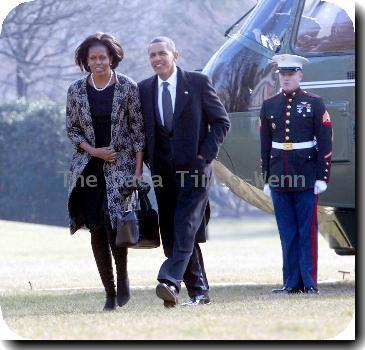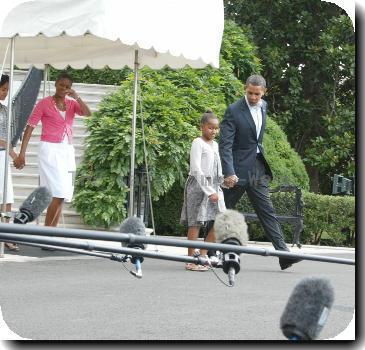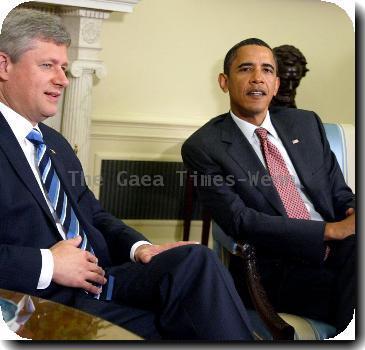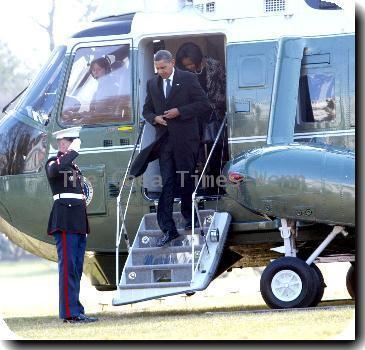Thousands of US, Afghan forces storm Taliban stronghold in biggest offensive since 2001
By Christopher Torchia, APSaturday, February 13, 2010
US, Afghan troops sweep into Taliban stronghold
MARJAH, Afghanistan — Thousands of U.S. Marines and Afghan soldiers stormed the Taliban stronghold of Marjah by air and ground Saturday, meeting only scattered resistance but facing a daunting thicket of bombs and booby traps that slowed their advance through the town.
It is the largest offensive since the 2001 U.S.-led invasion of Afghanistan. The operation aims to establish Afghan government authority over the biggest southern town under militant control and break the Taliban grip over a wide area of their southern heartland.
Maj. Gen. Nick Carter, NATO commander of forces in southern Afghanistan, said Afghan and coalition troops, aided by 60 helicopters, made a “successful insertion” into Marjah in southern Helmand province. He said the operation was going “without a hitch.”
But there were military casualties. The British Ministry of Defense said one of its soldiers was killed by an explosion while on vehicle patrol in Nad Ali district, north of Marjah. Another NATO service member, whose nationality was not immediately disclosed, was killed by gunfire, a spokesman for the coalition said.
Elsewhere in the south, three U.S. soldiers were killed by a bomb in an attack unrelated to the operation, NATO said.
Though the bulk of the troops attacking Marjah are American, British and Canadian troops also swept into Taliban areas to the north of the town, seeking to clear a wide swath of villages that had been under Taliban control for several years.
A British general said the more than 1,000 U.K. troops involved “have successfully secured the area militarily.”
Maj. Gen. Gordon Messenger told reporters in London that British troops have only had to deal with “sporadic attacks from a distance” and roadside bombs.
The long-awaited assault on Marjah is a key test of a new NATO strategy focused on protecting civilians. The attack is also the first major combat operation since President Barack Obama ordered 30,000 U.S. reinforcements here in December to try to turn the tide of the war.
At least 20 insurgents were killed in the operation, said Gen. Sher Mohammad Zazai, the commander of Afghan forces in the region. Troops have also recovered Kalashnikov rifles, heavy machine guns and grenades from 11 insurgents captured so far.
The few civilians who ventured out to talk to the Marines said teams of Taliban fighters were falling back deeper into the town, perhaps to try to regroup and mount harassment attacks to prevent the government from rushing in aid and public services — a key step in the operation.
President Hamid Karzai called on Afghan and international troops “to exercise absolute caution to avoid harming civilians,” including avoiding airstrikes in areas where civilians are at risk. In a statement, he also called on insurgent fighters to renounce violence and reintegrate into civilian life.
A Taliban spokesman insisted the insurgents were still resisting the allied assault and that the town remained under their control.
“The Taliban are there and they are fighting. All of Marjah is still under Taliban control,” Qari Yousef Ahmadi told The Associated Press by phone. He declined to say how many Taliban fighters remained in the town but dismissed accounts of 20 dead as “propaganda.”
Lt. Col. Brian Christmas, commander of the 3rd Battalion, 6th Marines, said U.S. troops faced sustained gunbattles in four areas of the town, including the western suburb of Sistani where India Company faced “some intense fighting.” To the east, Kilo Company was inserted by helicopter but was then “significantly engaged” as the Marines fanned out from the landing zone.
But the greatest threat came from the extensive network of mines, homemade bombs and booby traps that ground forces encountered as soon as they crossed a major major canal into the town’s northern entrance.
Insurgents appeared to have withdrawn from the front line but left explosives in their positions and in the network of canals built by the Americans in the 1950s and 1960s. Marines safely set off numerous bombs and the sound of strong detonations reverberated through the dusty streets.
“It’s just got to be a very slow and deliberate process,” said Capt. Joshua Winfrey of Stillwater, Okla., a Marine company commander.
The bridge over the canal into Marjah from the north was so rigged with explosives that Marines erected temporary bridges to cross into the town.
Lance Corp. Ivan Meza, 19, was the first to walk across one of the flimsy bridges.
“I did get an adrenaline rush, and that bridge is wobbly,” said Meza, a Marine combat engineer from Pismo Beach, California, who is with the 1st Platoon, Lima Company, 3rd Battalion, 6th Marines.
Several civilians hesitantly crept out of their compounds as the Marines slowly worked through a suspected mine field.
Shopkeeper Abdul Kader, 44, said seven or eight Taliban fighters, who had been holding the position where the Marines crossed over, had fled in the middle of the night. He said he was angry at the insurgents for having planted bombs and mines all around his neighborhood.
“They left with their motorcycles and their guns. They went deeper into town,” he said as Marines and Afghan troops searched a poppy field next to his house. “We can’t even walk out of our own houses.”
Saturday’s ground assault followed many hours after an initial wave of helicopters carrying hundreds of U.S. Marines and Afghan troops swooped into town under the cover of darkness before dawn, firing missiles at tunnels and bunkers.
Marine commanders had said they expected between 400 to 1,000 insurgents — including more than 100 foreign fighters — to be holed up in Marjah. The town of 80,000 people, about 360 miles (610 kilometers) southwest of Kabul, is the linchpin of the militants’ logistical and opium-smuggling network.
The offensive, code-named “Moshtarak,” or “Together,” was described as the biggest joint operation of the Afghan war, with 15,000 troops involved, including some 7,500 in Marjah itself. The government says Afghan soldiers make up at least half of the offensive’s force.
Once Marjah is secured, NATO hopes to rush in aid and restore public services in a bid to win support among the estimated 125,000 people who live in the town and surrounding villages. The Afghans’ ability to restore those services is crucial to the success of the operation and to prevent the Taliban from returning.
Carter said coalition forces hope to install an Afghan government presence within the next few days and will work to find and neutralize improvised explosive devices — homemade bombs — left by the militants.
Others were more cautious about the speed with which government can be installed.
“I can’t yet say how long it will take for this military phase to get to the point where we can bring in the civilian support from the Afghan government. We hope that will happen quickly,” NATO’s civilian chief, Mark Sedwill, said in Kabul.
Teams of international development workers and Afghan officials are ready to enter the area as soon as security permits. A deputy district chief has already been appointed for Marjah and government teams have drawn up maps of where schools, clinics and mosques should be built.
Sedwill said a key part of establishing government in Marjah will be a series of meetings with tribal elders, much like two meetings that preceded the offensive to listen to their concerns.
Tribal elders have pleaded for NATO to finish the operation quickly and spare civilians — an appeal that offers some hope the townspeople will cooperate with Afghan and international forces once the Taliban are gone.
Still, the town’s residents have displayed few signs of rushing to welcome the attack force.
“The elders are telling people to stay behind the front doors and keep them bolted,” Carter said. “Once people feel more secure and they realize there is government present on the ground, they will come out and tell us where the IEDs are.”
Associated Press writers Noor Khan in Kandahar, Rahim Faiez and Heidi Vogt in Kabul and Stephen Braun in Washington contributed to this report.
Tags: Afghanistan, As-afghanistan, Asia, Barack Obama, Bombings, Central Asia, England, Europe, Geography, Improvised Explosives, Kabul, London, Marjah, Municipal Governments, North America, United Kingdom, United States, War Casualties, Western Europe







